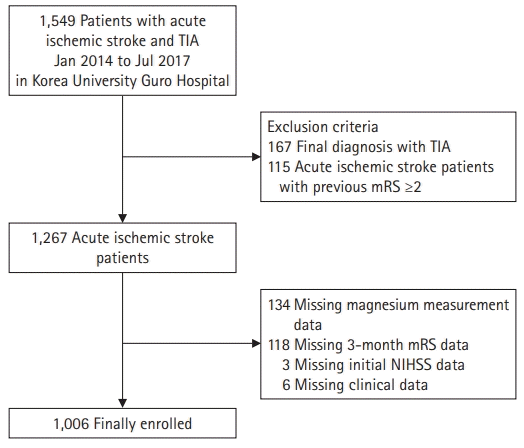INTRODUCTION
METHODS
Study population
Data collection
Definitions and interpretation
Statistical analysis
RESULT
Table 1.
| Variable | Serum magnesium <1.6 mEq/L | Serum magnesium ≥1.6 mEq/L | P-value |
|---|---|---|---|
| Age (yr) | 66±15 | 67±13 | 0.306 |
| Sex (male) | 64 (55.7) | 587 (65.9) | 0.031a) |
| Hypertension | 79 (68.7) | 510 (57.2) | 0.019a) |
| Diabetes mellitus | 60 (52.2) | 230 (25.8) | <0.001a) |
| History of ischemic stroke | 11 (11.2) | 87 (9.8) | 0.946 |
| History of atrial fibrillation | 31 (27.0) | 152 (17.1) | 0.010a) |
| Current smoker | 28 (24.3) | 276 (31.0) | 0.145 |
| SBP (mmHg) | 147±29 | 150±28 | 0.365 |
| DBP (mmHg) | 86±14 | 87±16 | 0.311 |
| Total cholesterol (mg/dL) | 164 (141–200) | 186 (158–215) | <0.00a) |
| TG (mg/dL) | 101 (78–157) | 110 (78–158) | 0.893 |
| HDL-C (mg/dL) | 42 (35–50) | 42 (35–50) | 0.396 |
| LDL-C (mg/dL) | 91 (72–123) | 111 (88–134) | <0.001a) |
| Initial NIHSS | 3 (1–7) | 3 (1–6) | 0.334 |
| TOAST classification | 0.019a) | ||
| Large artery atherosclerosis | 34 (29.6) | 297 (33.3) | |
| Cardioembolism | 32 (27.8) | 145 (16.3) | |
| Small vessel occlusion | 18 (15.7) | 221 (24.8) | |
| Others | 5 (4.3) | 37 (4.2) | |
| Undetermined | 26 (22.6) | 191 (21.4) |
Values are presented as mean±standard deviation, number (%), or median (interquartile range).
SBP, systolic blood pressure; DBP, diastolic blood pressure; TG, triglycerides; HDL-C, high-density lipoprotein cholesterol; LDL-C, low-density lipoprotein cholesterol; NIHSS, National Institutes of Health Stroke Scale; TOAST, Trial of Org 10172 in Acute Stroke Treatment.
Table 2.
| Variable | Crude OR (95% CI) | P-value | Adjusted OR (95% CI) | P-value |
|---|---|---|---|---|
| Hypomagnesemia (serum magnesium <1.6 mEq/L) | 2.29 (1.45–3.62) | <0.001 | 2.15 (1.16–3.98) | 0.015a) |
| Age (yr) | 1.08 (1.06–1.10) | <0.001 | 1.07 (1.04–1.09) | <0.001a) |
| Sex (male) | 0.81 (0.56–1.15) | 0.234 | 1.42 (0.85–2.39) | 0.180 |
| Hypertension (yes) | 2.14 (1.45–3.15) | <0.001 | 1.95 (1.17–3.26) | 0.011a) |
| Diabetes mellitus (yes) | 1.30 (0.90–1.88) | 0.168 | 1.18 (0.72–1.93) | 0.507 |
| History of ischemic stroke (yes) | 1.55 (0.92–2.62) | 0.103 | 0.98 (0.49–1.94) | 0.942 |
| Current smoker (yes) | 0.64 (0.43–0.97) | 0.034 | 1.25 (0.70–2.22) | 0.447 |
| 10-Unit increment in total cholesterol (mg/dL) | 0.94 (0.9–0.99) | 0.009 | 1.02 (0.95–1.06) | 0.955 |
| Initial NIHSS | 1.31 (1.26–1.36) | <0.001 | 1.32 (1.26–1.38) | <0.001a) |
| Cardioembolism (TOAST) | 3.14 (2.13–4.62) | <0.001 | 0.83 (0.47–1.49) | 0.534 |
Table 3.
| Variable |
Serum magnesium ≥1.6mEq/L |
Serum magnesium <1.6 mEq/L |
P-value of interaction term | ||
|---|---|---|---|---|---|
| Adjusted OR (95% CI) | P-value | Adjusted OR (95% CI) | P-value | ||
| Initial NIHSS (dichotomized) | 0.047a) | ||||
| Minor (<5) | 1 (Ref) | 4.20 (1.67–10.59) | 0.002 | ||
| Moderate-severe (≥5) | 16.27 (9.39–28.19) | <0.001 | 21.58 (9.68–48.15) | <0.001 | |
| Cardioembolism (TOAST) | 0.053 | ||||
| No | 1 (Ref) | 1.44 (0.67–3.10) | 0.357 | ||
| Yes | 0.62 (0.32–1.21) | 0.161 | 3.41 (1.24–9.41) | 0.018 | |
| Hypertension | 0.461 | ||||
| No | 1 (Ref) | 1.37 (0.35–5.37) | 0.651 | ||
| Yes | 1.82 (1.06–3.13) | 0.031 | 4.42 (1.99–9.80) | <0.001 | |
| Age (dichotomized) | 0.753b) | ||||
| <65 yr | 1 (Ref) | 2.68 (0.78–8.97) | 0.120 | ||
| ≥65 yr | 3.84 (2.03–7.26) | <0.001 | 8.11 (3.38–19.48) | <0.001 | |
In all analyses, the same variables in Table 2 were included in the adjustment except for the stratification variable.
OR, odds ratio; mRS, modified Rankin Scale; CI, confidence interval; NIHSS, National Institutes of Health Stroke Scale; TOAST, Trial of Org 10172 in Acute Stroke Treatment.




 PDF
PDF Citation
Citation Print
Print




 XML Download
XML Download